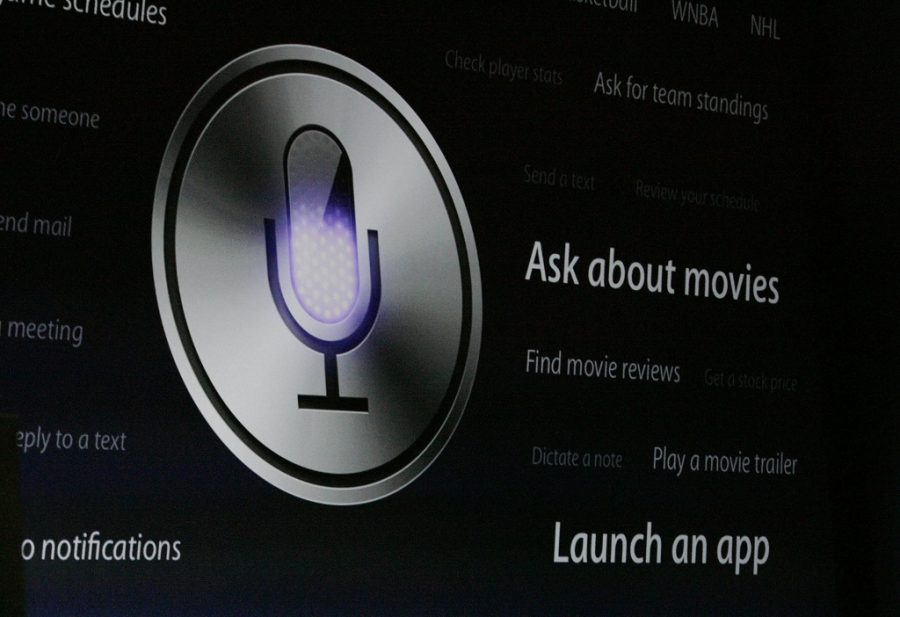Troy Wolverton: At CES, voice assistants assert themselves
The Siri logo is shown on the big screen during a demo at the annual Worldwide Developers Conference in San Francisco in 2012. A new study suggests that Siri and other smartphone personal assistants can’t adequately help users with issues of mental health, interpersonal violence and physical health. (Gary Reyes/Bay Area News Group/TNS)
January 17, 2017
By Troy Wolverton
LAS VEGAS — In the very near future, instead of controlling your gadgets by pressing buttons or tapping on screens, you may just talk to them.
Intelligent assistant technology like Apple’s Siri and Amazon’s Echo is starting to spread widely. At this year’s recently concluded CES, numerous companies showed off devices ranging from refrigerators to plush dolls that respond to voice commands and queries.
“Intelligent assistants allow for a more intuitive way to interact with all these devices,” said John Curran, managing director of consulting company Accenture’s communications, media and technology practice.
Voice control by itself isn’t new. Consumers have been able to dial phone numbers on cellphones or interact with automated phone service systems using only their voice for more than a decade. Apple’s Siri has been around for more than six years and was joined more recently by Microsoft’s Cortana, the Google Assistant and Alexa.
What is new is that voice control is starting to become more commonplace. Apple and Amazon are working with smart home companies so their products can be controlled by Siri and Alexa, respectively. Amazon is starting to widely license its Alexa technology so that it can be built into other devices. Now even smaller companies can incorporate Alexa or similar features.
Helping drive this are rapid advancements in voice recognition. The first voice recognition systems that debuted in the 1990s had extraordinarily high error rates; they had a super-difficult time recognizing spoken words. Even as recently as 2013, such systems had an error rate of about 23 percent, said Shawn DuBravac, chief economist at the Consumer Technology Association, which puts on CES.
But now, about three years later, such systems have reached near parity with humans.
“We’ve made more progress in the last 30 months than in first 30 years,” he said, adding that “the next computer interface is voice.”
The most prevalent area where voice control is showing up is in smart speaker systems. Amazon pioneered that category with the Echo two years ago and was joined in the market by Google Home this past fall. But it will soon have a whole host of other competitors.
Some of these new smart speaker systems, like Lenovo’s Smart Assistant, not only look like the Echo, they also will employ its Alexa voice assistant technology. Others, though, look and act distinctly different.
Emotech’s Olly, for example, looks like a big black donut. When you talk to it, it will rotate to face you. So will LG’s Hub Robot, which has a screen that looks something like a face, with two blue dots for eyes.
Many of these new speaker systems are designed to work much like the Echo. They can play music on command. They can answer queries, such as “How far away is the sun?” And they can control smart home products.
But some new smart speakers are intended for more narrow uses. Hello Egg, which looks like a black egg with a big round eye, is designed to be used in the kitchen. You can use it to order groceries or plan meals. And it has a screen that can display recipe videos all on voice command.
Some new smart speakers are aiming to do even more than Echo. SmartBeing’s WooHoo, includes a camera and a large screen that can be used for home surveillance or to make video calls.
CTA’s DuBravac estimates that about 5 million smart speaker systems have been sold to date. He predicts the industry will sell another 5 million this year alone.
But smart speakers aren’t the only place where voice assistants are starting to take hold. Both LG and Samsung showed off refrigerators that will play music or order groceries on voice command. Vinci’s smart headphones have a built-in intelligent assistant that will play music, offer directions or give you a weather update if you just ask, without needing to be connected to a smartphone. And startup company Woobo is working on a smart stuffed animal that can answer your kids’ precocious questions about the way the world works.
And products such as these are likely only the first of a big wave of voice controlled gadgets and technologies. In fall, Samsung acquired Viv, a next-generation intelligent assistant designed by the same people who created Siri. Meanwhile, in its suite here during CES, IBM showed off several different products that tapped into its Watson artificial intelligence technology that could be controlled with users’ voices.
In one demonstration, IBM representatives showed how a hotel visitor could change the channel on their TV or close their blinds by talking to a JBL speaker. In another demo, they showed how an office worker could set up a video conference with a particular group of colleagues just by talking to a soundbar. And in yet another demo, they showed how a consumer could get information about their day or schedules just by talking to a smart mirror.
The prototypes suggest that not only are voice assistants likely to spread, but they’re likely to gain new capabilities in coming years.
So put down your finger and clear your voice. Your devices will be listening.








